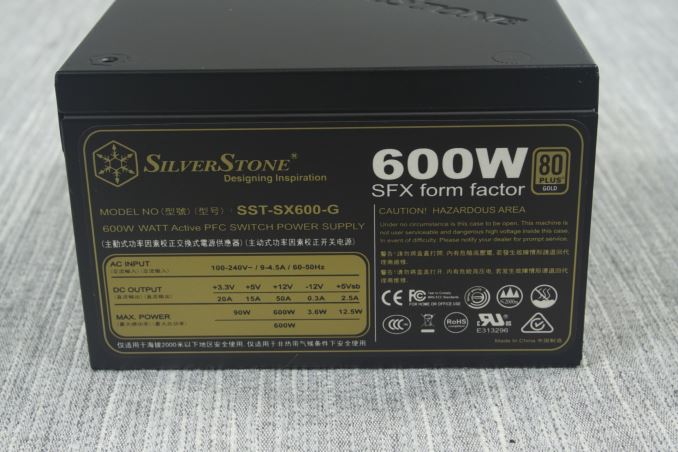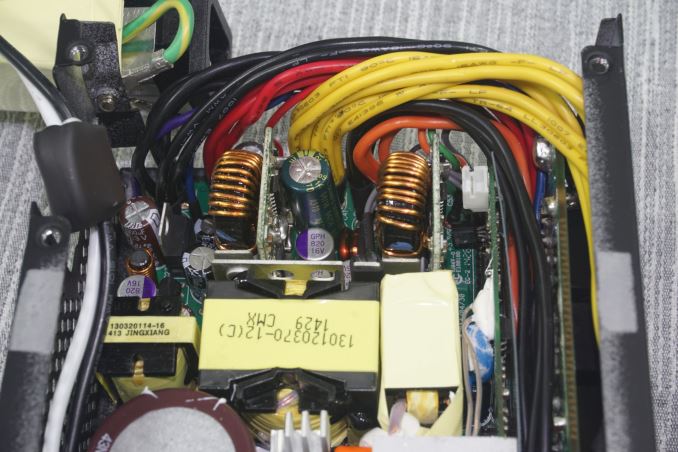The SilverStone SX600-G SFX PSU Review
by E. Fylladitakis on August 21, 2015 8:00 AM EST- Posted in
- PSUs
- Cases/Cooling/PSUs
- 80Plus Gold
- SilverStone
- SFX
- 600W
- Enhance
Conclusion
Unlike the more flexible ATX solutions, the SilverStone SX600-G SFX PSU is a rather narrowly focused product, designed for a very specific group of users. Frankly, the number of users that would even want a 600 Watt PSU inside their tiny desktop/SFF case is very small, let alone the number of those users who could use that much power given the component limitations imposed by such small case dimensions. Which is not to say that there's not a place for a 600W SFX PSU, only that it's definitely a niche role on the whole.
Unsurprisingly then, for this 600W unit SilverStone is trying to expand their customer base a little bit with the inclusion of the SFX to ATX frame adapter. After all, even if a small form factor case can take a full size ATX PSU, a very compact design might benefit from the presence of a smaller SFX PSU. Unfortunately in trying to serve two masters, Silverstone's included modular cables are still designed first and foremost for the smaller SFX form factor, meaning that they don't offer much slack for actually reaching an ATX motherboard. We fell victim to this as well, during our recent review of SilverStone's own Fortress FT05. Despite the small proportions of the case, the CPU power connector could not get anywhere close the motherboard header.
Meanwhile when it comes to performance, it would be entirely unfair to compare the SilverStone SX600-G to any ATX PSU and, frankly, we do not have enough data to compare it against any other SFX PSU either. High performance SFX PSUs are quite rare, and most are built by Enhance anyway.
What we can point out however is that the SilverStone SX600-G SFX struggles to deliver its maximum power output inside a hot environment and, unlike a good gaming tower case, we do expect a small desktop/SSF case to get rather warm given the lack of airflow in most home A/V cabinets. In a hot, enclosed space, the PSU struggles to meet its efficiency certification levels and the power quality is, to put it mildly, not good. As one might expect noise levels in hot conditions are not very good either, as the included 80mm fan has to work rather hard to keep component temperatures in check.
What this means is that the SX600-G is not a very forgiving PSU. If put in a well ventilated room temperature environment the PSU does well enough, you just need good ventilation to start with. Particularly if driven to its full capacity, great care needs to be taken to make sure that the SX600-G and the system it's placed in are well ventilated in order to get suitable performance out of the PSU (and likely the rest of the system as well)
Ultimately there were clearly some tradeoffs made to get a 600W PSU into such a small form factor design, with ambient temperature sensitivity being chief among them. If we were to compare its performance with an average ATX PSU retailing for half the price, the SX600-G clearly falls short. It is not however made to be compared to ATX units, and rather this is one of the highest outputs you can get in the SFX form factor.
Moving on, the quality of the SilverStone SX600-G SFX PSU is troubling at times as well. Enhance does a fine job as an OEM and we have no complaints about the design or the quality of the assembly. For the most part, the quality of the components is good. The active components are of good quality and the primary capacitor is supplied by a very respectable manufacturer. When we check the secondary components however, it is pure chaos, with the capacitors being supplied by over half a dozen manufacturers despite the fact that this is a small SFX PSU.
Of course, the number of suppliers means very little. The fact that many of them are not exactly favorites among enthusiasts however, does. Most of those versed in power electronics would agree that products from, for example, Su'Scon and Elite, are not exactly ideal for what is supposed to be a high performance $130 product. For what amounts to a premium retail price, one would expect better quality. Then again, we can only imagine what it would do to the already premium price of the PSU if Silverstone went with even more expensive top class components.
Wrapping things up, although it's not perfect, the SilverStone SX600-G SFX PSU is still going to be the PSU of choice for those that need a high power output inside a very confined environment. It comes at the steep price of $130 including shipping, but there is virtually no other product that can match its power output in such a small size. But with that said, this is a PSU best reserved for SFX form factor users. If a case can accept a normal ATX PSU, an ATX PSU is probably the better and cheaper option.












20 Comments
View All Comments
duyfken - Friday, August 21, 2015 - link
Any chance of reviews on the Corsair SF600 (competing 600W SFX and 92mm fan in the SFX form factor with High Power as OEM) or Silverstone SX500-LG (500W Extended SFX form factor with 120mm fan and again the OEM is High Power)?E.Fyll - Saturday, August 22, 2015 - link
It is very likely, yes. One thing at the time.Corsair's model is not available yet.
duyfken - Saturday, August 22, 2015 - link
Cheers, good news for more informed decisions on (many) future iTX builds :)tonyou - Sunday, August 23, 2015 - link
High Power is not the OEM for SF600 (it was in fact Great Wall) according to Corsair's own personnel:http://www.jonnyguru.com/forums/showthread.php?t=1...
StrangerGuy - Saturday, August 22, 2015 - link
I wish SFX is the new mainstream standard for PSUs. The sheer size of ATX PSUs is wastingso much physical space inside a mITX/mATX enclosure, and the vast majority of users simply doesn't need more than 400W even for a gaming PC with power requirements dropping like a rock since 2011.Or even better, a complete move to a +12V DC PSU standard to cut down even more PSU circuitry and save more space at the same time.
sor - Saturday, August 22, 2015 - link
Most power supplies are more efficient at higher voltage, not less. It would be interesting to see you retest at 120vDanNeely - Saturday, August 22, 2015 - link
He can't. He lives in a country with 220V wall power; which means the only way to get 120V is a huge transformer.sor - Saturday, August 22, 2015 - link
Only because it's a quickie review. It wasn't that long ago that I remember seeing PSU reviews here where they were opening them up and critiquing the internals and choices of components, looking at electrical noise of the switching IC, rectifier, and MOSFETs, etc. I think Anandtech could arrange to test a PSU at both common voltages/frequencies if they wanted to make a good quality review. A desktop variac can probably be picked up for the price of this PSU or less and could be used for many reviews. Or perhaps they employ someone stateside who could run a few tests on the same model.I get that this is just a drive-by review for the weekend that isn't intended to be a thorough or high budget affair. And I don't really even know if they're the type who just ships free stuff from manufacturers to your house to try out or if they have invested a couple of hundred into various lab equipment on regular occasion to do proper testing, but I feel like review sites used to lean toward the latter and we are losing that slowly in favor of review mills.
At any rate, the only reason any of this came up is because the reviewer mentioned that it didn't meet 80 plus. That seems like an interesting thing to dig into, because one familiar with power supplies would expect the situation to get worse at 120v.
E.Fyll - Monday, August 24, 2015 - link
Actually, that is entirely wrong. I do have a VARIAC and I do use it to get an exact 230 VAC output. However, dropping the voltage down to 110/120 Volts is just false/fake testing. You see, VARIACs convert the voltage output but do nothing about the frequency. Whoever is claiming to be using a VARIAC for dual voltage testing, sorry, that's just wrong.To perform testing at any voltage/frequency, you need a programmable power source. One in the range of 2-3 KVA costs about $25.000. I do not think that I need to explain why I do not have one.
home improve - Tuesday, August 25, 2015 - link
Depending on the games an individual plays, it is advisable to a high-end graphics card for several reasons such as stereoscopic 3D...<a href="http://www.myhomeimprovementsolutions.com/best-gam... games</a>